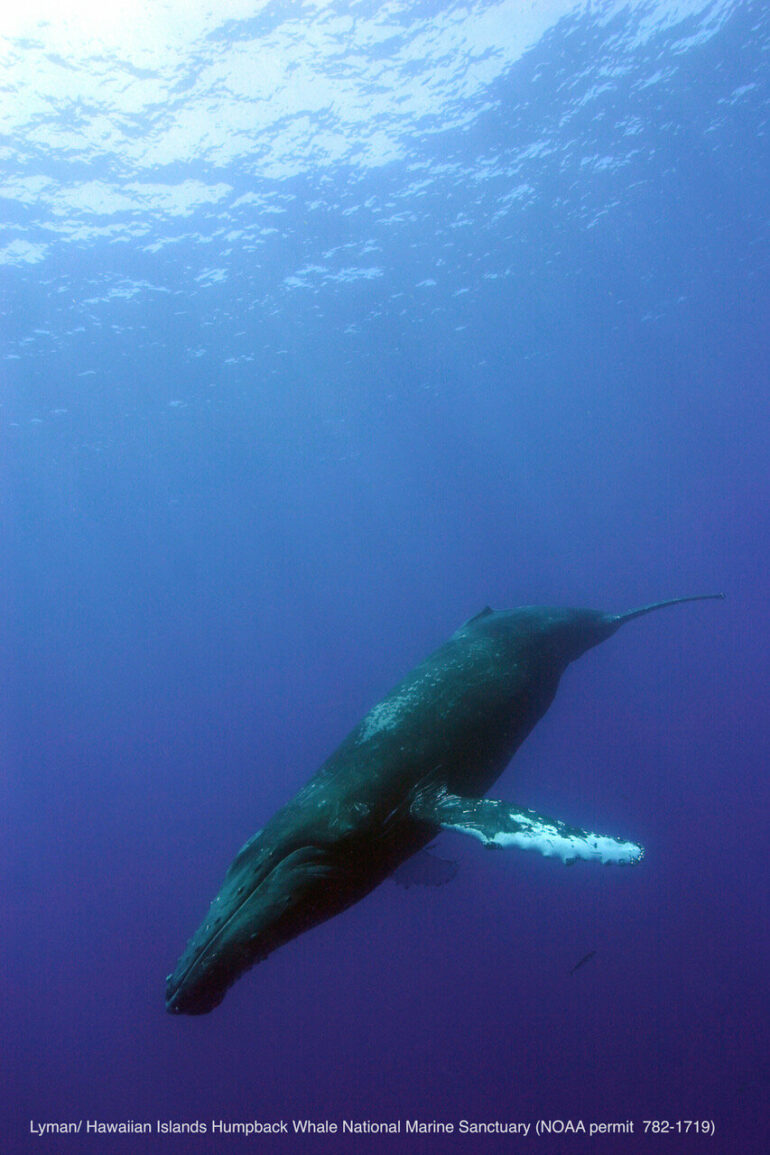Humpback whale singing dominates the marine soundscape during winter months off Maui. However, despite decades of research, many questions regarding humpback whale behavior and song remain unanswered. New research has revealed a daily pattern wherein whales move their singing away from shore throughout the day and return to the nearshore in the evening.
The findings were led by the University of Hawaiʻi, in partnership with NOAA’s Hawaiian Islands Humpback Whale National Marine Sanctuary, and published in Royal Society Open Science.
“Singers may be attempting to reduce the chances of their song being drowned out among the cacophony nearshore when whale numbers are high,” said Anke Kügler, lead author of the study who was a doctoral student in the Marine Biology Graduate Program at UH Mānoa at the time of the research. “Further, we documented humpback whales moving closer to shore around sunset, possibly to avoid the offshore evening chorus of other animals.”
By using a combination of underwater listening devices and visual surveys, the research team was able to track both the physical movements and the acoustic patterns of whales in the high-density breeding grounds found in Hawai’i.
“This dynamic onshore-offshore movement of singers may be aimed at increasing the efficiency of the whales’ acoustic display, ensuring that other whales hear their songs,” said Marc Lammers, study co-author and research ecologist with NOAA’s Hawaiian Islands Humpback Whale National Marine Sanctuary.
“This is the first effort of its kind, to our knowledge, in which we used specialized acoustic sensors to localize individual singers relatively close to shore to understand daily variations in the distance to shore of these nearshore singers, their spacing, and their movement behavior,” said Kügler. “This helped contextualize the visual results and overcome some of the limitations from the land-based visual observations of movement.”
Humpback whale song is presumed to play an important role for breeding. The new findings highlight the significance for male singers of an environment that is teeming with acoustic commotion. Through their approach, the team identified potential drivers for the daily onshore-offshore migrations—nearshore environments that are too crowded with whales during the day and offshore areas that are too noisy with the chorus of other animals in the evening.
“Discussions of noise pollution related to marine mammals have been dominated by concerns over anthropogenic noise,” said Kügler. “Potential acoustic masking from natural sources, including one whale masking another whale’s song, has been mostly overlooked. By exploring possible drivers of the observed patterns, we add to our understanding of how animals that rely on acoustic signals adopt behavioral strategies to mitigate masking from loud environments.”
Humpback whales are ecologically, economically, and culturally significant in Hawai’i, and their singing is iconic around the world.

Anke Kügler, Marc Lammers, Isabella Canepa (student) at the Olowalu land station conducting visual surveys. © Adam Pack
“It is our collective kuleana (responsibility) to be the koholā’s (humpback whales) stewards,” said Lammers. “This and future work contributes to fulfilling the Sanctuary’s management plan by developing and implementing crucial research on humpback whales and their habitats to help maintain a healthy, sustainable population.”
In addition to Kügler and Lammers, co-authors on the study include Adam Pack, professor of psychology and biology at UH Hilo, founder and director of the UH Hilo Marine Mammal Lab and co-founder of the LOHE bioacoustics lab; and Aaron Thode and Ludovic Tenorio-Hallé at Scripps Institute of Oceanography, University of California.
More information:
Anke Kügler et al, Diel spatio-temporal patterns of humpback whale singing on a high-density breeding ground, Royal Society Open Science (2024). DOI: 10.1098/rsos.230279
Provided by
University of Hawaii at Manoa
Citation:
Humpback whales move daytime singing offshore, research reveals (2024, January 24)
